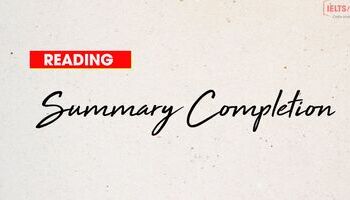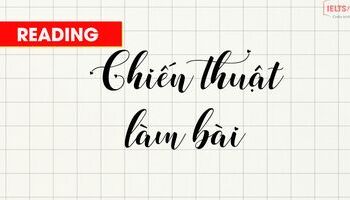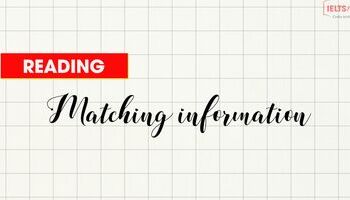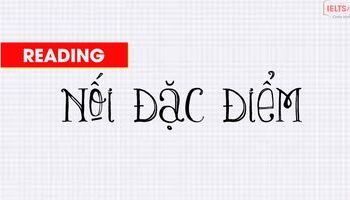Hôm nay lại là một dạng bài khá là thú vị trong IELTS Reading. Summary Completion là dạng bài thường xuyên xuất hiện, nếu không muốn nói là chắc chắn 100% sẽ ra. Nên các bạn chú ý nha.
1. Summary Completion trong IELTS Reading là gì?
Đây là dạng bài lấy điểm, nên bạn hãy đảm bảo rằng mình nắm chắc trong tay cách làm dạng bài này, vì thực sự đây là dạng bài không thể tránh khỏi và vô cùng quan trọng. Thường dạng này đề bài sẽ cho 1 đoạn văn ngắn, nội dung là tóm tắt của 1 đoạn hoặc 1 nội dung nào đó trong bài đọc, thường những nội dung này trong bài đọc sẽ gần sát với nhau để mình dễ tìm. Nhiệm vụ là mình phải biết cách họ paraphrase và tìm từ ngữ chính xác điền vào. Nói chung đây là bài toán PARAPHRASING!
Dạng điền từ này tương đối dễ nhưng nếu làm không cẩn thận thì cũng sai như thường, nếu đọc ẩu, nên đừng để bị mất điểm oan phần Completion này nhé! Cách làm cũng rất đơn giản thôi, bạn xem tiếp bên dưới nha!
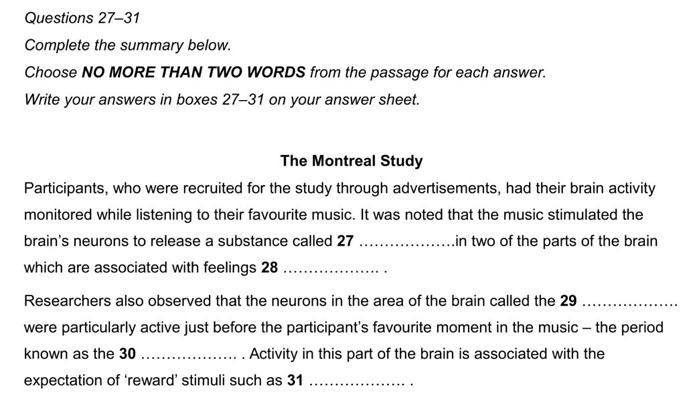
Cách làm bài mình sẽ nói bên dưới, các bạn nhìn sơ qua dạng bài nhé!
2. Cách làm bài Summary Completion
Bước 1: Khoanh tròn số từ cần điền
Thường mình thấy dạng bài này hay cho “ONE WORD ONLY” là phổ biến nhất, và mình tin đề thi thật cũng sẽ thường hơn 90% sẽ cho One Word chứ ít khi nào Two or Three Words.
Tức là sao? Tức là bạn chỉ cần tìm “1 từ duy nhất” thích hợp để điền vào chỗ trống.
Cũng như mình đã nói ở bài trước, sẽ có những câu bạn đã spot được câu trả lời rồi, câu trả lời của bạn gồm 2 từ, ví dụ như “red bottle”, mà đề bài chỉ cho điền “one word” thì theo mình bạn nên lược bỏ bớt 1 từ không quan trọng trong đó.
Ví dụ như trong cụm trên là “red”, chỉ điền vào “bottle” thôi vì red mang tính miêu tả cho sự vật. Nhưng có những trường hợp lại loại bỏ sai mất từ cần điền đó nhé, nên bạn hãy luyện tập thật nhiều để biết cách ra đề của IELTS và cách IELTS cho đáp án thường sẽ như thế nào!
Bước 2: Đọc nội dung đoạn tóm tắt + Xác định vị trí trong bài đọc
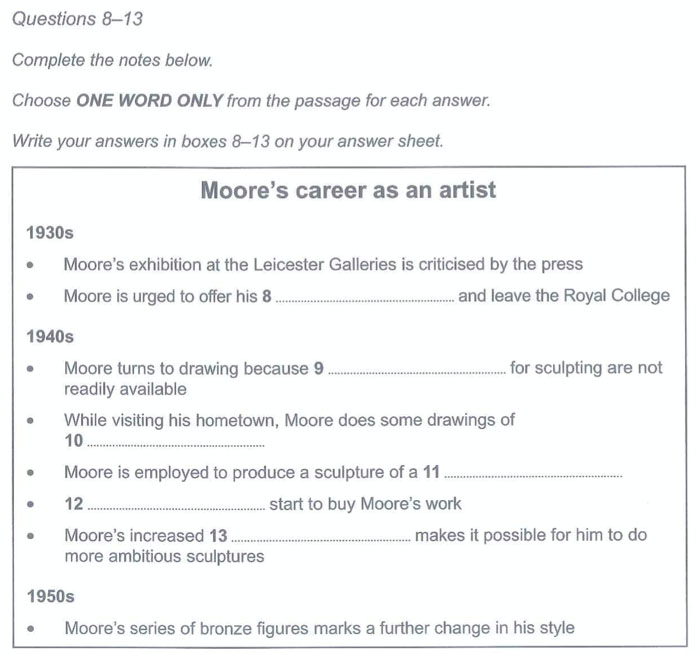
Ví dụ trên mình lấy trong Cambridge 15, test 3. Các bạn thấy đây là 1 dạng điền từ “One Word Only” – chỉ điền 1 từ vào chỗ trống.
Việc đầu tiên đó là mình sẽ đọc title “Moore’s Career as an artist”, tức là nội dung sẽ về sự nghiệp làm họa sĩ của ông Moore này. Vậy đoạn nào trong bài đọc nói về career làm artist của ổng thì cần phải chú ý hơn.
Sau đó có những mốc thời gian rất rõ ràng như 1930s, 1940s, 1950s nên chúng ta sẽ dễ kiếm trong bài đọc dựa vào kỹ năng sanning để spot những thời gian này nằm ở đâu trong bài.
Sau đó mình thường đọc lướt cả đoạn hoặc 1-2 câu đầu để biết mình cần điền những gì, loại từ nào, thông tin về cái gì.
Tiếp theo, mình sẽ gạch chân những từ xung quanh chỗ trống vì chắc chắn sẽ bị paraphrase trong bài, đó chính là những từ rất quan trọng giúp mình phát hiện “One Word Only” ở đây chính xác là từ nào.
Sau khi nghiên cứu khoảng 10 - 15 giây cho những bước trên rồi thì tiến hành đọc bài đọc và xác định đoạn có nội dung như trên thôi.
Bước 3: Tìm từ và check đáp án
Thường mình sẽ tìm từ bằng cách paraphrase liên tục, để cho dễ hiểu mình sẽ lấy ví dụ nhé! Nhìn vào hình trên, câu số 8:
“Moore is urged to offer his ………. and leave the Royal College.”
Tips:
- Chú ý từ “his” để xác định từ cần điền chính xác là từ nào.
- Chú ý “Royal College” để xác định đoạn này nằm ở vị trí nào trong bài.
Đoạn văn trong bài:
There were calls for his resignation from the Royal College, and the following year, when his contract expired, he left to start a sculpture department at the Chelsea School of Art in London.
Cách làm:
- Spot được từ Royal College, đã tìm đúng đoạn.
- Moore is urged to offer his ………. and leave the Royal College
Câu này có 2 vế.
Vế 1 là “Moore is urged to offer his …..”.
Vế 2 là “leave the Royal College”
- Xác định vế 2: and leave the Royal College = and the following year, when his contract expired, he left to start a….
- Như vậy vế 1 sẽ nằm trong đoạn còn lại “There were calls for his resignation from the Royal College”
- Nhìn từ cần điền là “his….”
-> Vậy đáp án là his “resignation”
Như vậy các bạn thấy, mình vừa giải quyết 1 câu mà không cần dịch nghĩa của đoạn đó. Chỉ dựa vào những gì mình thấy trong đề bài và trong bài đọc, so sánh qua lại, suy luận và chọn luôn đáp án. Nhưng với bản thân mình, mình vẫn khuyến khích các bạn đọc – hiểu, như vậy tốc độ và độ chính xác sẽ cao hơn!
3. Luyện tập
Sensory Overload
A Are you suffering from a feeling of annoyance? Does life seem to get more and more irritating all the time? Do you struggle day to day just to stay calm and clear-headed in the face of more and more frustrating experiences? If your answer to these questions is “YES,” you are not alone. In fact, you are part of a growing trend that demonstrates the significance of the small events which annoy us on a day to day basis.
B According to psychologist Maurice Penman, inhabitants of today’s modern cities face a far more aggressive range of sensory experiences than ever before. “It is not simply that the pace of life is faster in today’s world, or that people are under more pressure at work. Of course, both those things are true. But today people are exposed to a greater number of both visual and auditory stimuli. Basically, this means we are being asked to both look at and listen to far more than we ever have been before."
C However, Penman is quick to point out that many of the things which are contributing to these problems are also the same things many of us value. A greater sense of irritation is the price we pay for the convenience of the Internet and mobile phones. “Mobile phones are a very significant example to consider. There is no doubt that they are useful in a multitude of ways, and most people do not want to go back to the days before them. But at the same time, mobile phones have almost completely destroyed a sense of quiet public space. There was a time when you could rely on public transport being relatively quiet, a place to think about the events of the day on the way home. Now a bus or a train carriage can feel like being locked in a busy office.”
D The increase in sensory demands is not just due to the use of mobile phones. Advertisers are reaching out to potential consumers more aggressively than ever. News services are now broadcast on buses and at train platforms. Family meals are frequently interrupted by telephone canvassers and email users are often forced to deal with an avalanche of unsolicited promotional messages, or “SPAM”. One could easily imagine that our children and their children may have to guard their homes from an overwhelming amount of annoyance
E While it is difficult to deny the growth in these increasingly annoying events in our day, is there actually any real significance to these facts? Penman argues: “There is no doubt that on the surface, this increase of stimuli in our day simply appears to be a matter of minor annoyance. But when we look closely, we can see that this has the potential to significantly affect our psychological health.” He goes on to explain that if exposure to these irritations is frequent and prolonged, very subtly our stress levels begin to rise. As they do, we find there is a compound effect. Stress from the minor episodes in the day starts to increase our feeling of pressure when faced with major challenges at work. We are increasingly carrying a greater and greater stress load, with opportunities to relax and unwind more and more restricted. Penman points out that even though we all sometimes crave stimulation, we have become so obsessed with it in the twenty-first century that it has now become almost impossible to avoid. Shops increasingly feel the need to play loud, thumping rock or techno music. Advertising becomes more and more energetically aggressive all the time. This, Penman maintains, prevents us from dealing with our daily stress and eliminating it from our systems. He adds: “You really do need to get right out of the city and into a quiet space now, though most of us are too busy to do that very often.”
F It might be easy for critics to dismiss the annoying experience of too many mobile phones on the bus, or any of the other stimuli Maurice Penman cites. However, it is the failure to eliminate stress which leads to potentially fatal consequences. If these daily distractions are contributing seriously to our stress levels, then Penman has identified a significant danger. We now know that stress truly is a killer, and has been implicated in the rise of depression, heart disease and even weight problems, as it increases hormones in the body which stimulate the appetite for fattening carbohydrate-rich foods.
G There is no denying that Maurice Penn's main arguments are compelling. It seems that stress has become so prevalent that people are getting stressed about their levels of stress. But what are we supposed to do? He suggests we do everything we can to go within ourselves and try to maintain a sense of personal peace and space. He recommends the use of meditation and relaxation tapes, exercise at the end of the day whenever possible and greater emphasis on fun. Unfortunately, Maurice Penman had no suggestions for those of us who find meditation frustrating, or who get annoyed at relaxation tapes. He had no recommendations for days when you can’t find any equipment you need in the gym, or find yourself irritated at those around you who keep saying you need to have more fun.
*Note: Đây là 1 dạng bài điền từ + bài đọc tương đối khó ^^ Khó hơn đề thi thật nhé, nên các bạn thử sức nha!
Questions 21-24
Complete the summary below using words from the passage. Write NO MORE THAN FOUR WORDS for each answer.
Write the correct answers in boxes 21-24 on your Answer Sheet.
People in today’s world are faced with much more 21 ……………... stimulation than they used to be. On a daily basis, our modern conveniences represent small but significant 22……………….. , which contribute to increasing levels of stress. Psychologist Maurice Penman suggests that because people 23 ………………….. from time to time, we are now in a world where we can’t escape it. However, we must escape it and relax or there could possibly be 24 ………………………..
KEY ANSWER
21 visual and auditory
22 irritations
23 crave stimulation
24 fatal consequences
Link tải bản PDF nhé:
| SUMMARY COMPLETION |
Xem thêm bài học cùng lộ trình:
Sharpen your IELTS Reading Skill - MATCHING SENTENCE ENDINGS
Sharpen your IELTS Reading Skill - MATCHING HEADINGS
